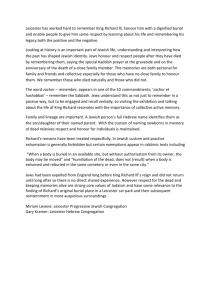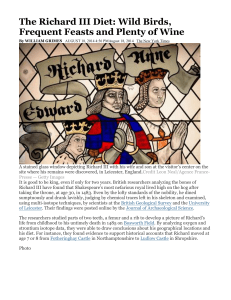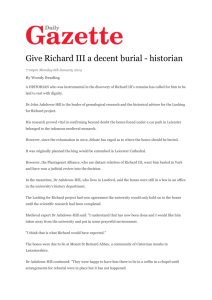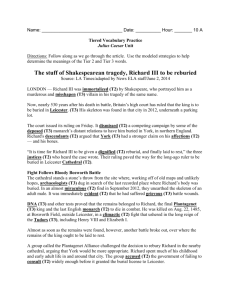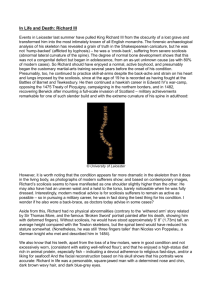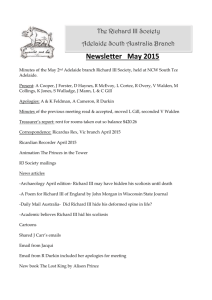Notes - University of Leicester
advertisement
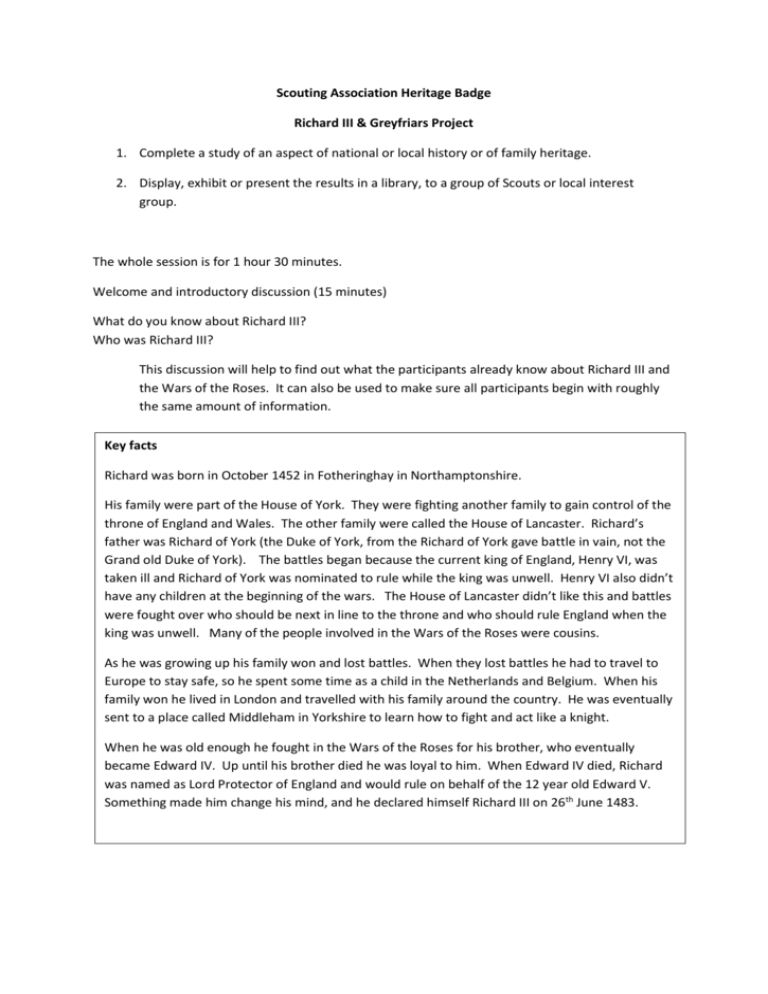
Scouting Association Heritage Badge Richard III & Greyfriars Project 1. Complete a study of an aspect of national or local history or of family heritage. 2. Display, exhibit or present the results in a library, to a group of Scouts or local interest group. The whole session is for 1 hour 30 minutes. Welcome and introductory discussion (15 minutes) What do you know about Richard III? Who was Richard III? This discussion will help to find out what the participants already know about Richard III and the Wars of the Roses. It can also be used to make sure all participants begin with roughly the same amount of information. Key facts Richard was born in October 1452 in Fotheringhay in Northamptonshire. His family were part of the House of York. They were fighting another family to gain control of the throne of England and Wales. The other family were called the House of Lancaster. Richard’s father was Richard of York (the Duke of York, from the Richard of York gave battle in vain, not the Grand old Duke of York). The battles began because the current king of England, Henry VI, was taken ill and Richard of York was nominated to rule while the king was unwell. Henry VI also didn’t have any children at the beginning of the wars. The House of Lancaster didn’t like this and battles were fought over who should be next in line to the throne and who should rule England when the king was unwell. Many of the people involved in the Wars of the Roses were cousins. As he was growing up his family won and lost battles. When they lost battles he had to travel to Europe to stay safe, so he spent some time as a child in the Netherlands and Belgium. When his family won he lived in London and travelled with his family around the country. He was eventually sent to a place called Middleham in Yorkshire to learn how to fight and act like a knight. When he was old enough he fought in the Wars of the Roses for his brother, who eventually became Edward IV. Up until his brother died he was loyal to him. When Edward IV died, Richard was named as Lord Protector of England and would rule on behalf of the 12 year old Edward V. Something made him change his mind, and he declared himself Richard III on 26th June 1483. Why Richard III and Leicester? (5 minutes) This section will put the topic in context. Why was Richard III in Leicester, why was Leicester important and what role did it play in the Wars of the Roses. Key facts Leicester lies in the middle of England and is on the cross roads of a number of roman roads. It has been of some importance because of this for centuries. The lands around Leicester often changed hands during conflicts, including when the Vikings invaded and during the Wars of the Roses. The Newarke was a Lancastrian stronghold and the castle was functioning up until 1480s, when it was thought to have fallen into disrepair. Richard III wrote a letter from Leicester Castle once, but stayed at the Blue Boar Inn in 1485. Richard III even proposed to hold a parliament in Leicester as it was a central point for the north and south to meet, but this was put off due to a rebellious uprising. Cardinal Wolsey stayed in Leicester on his trips around the country and eventually died and is buried at Leicester Abbey (Abbey Park). Leicester was also attacked during the Civil War in 1645 as it was a Parliamentarian stronghold. What happened in 1485? (5 minutes) Why did Richard III come to Leicester in 1485, why did the battle happen at Bosworth Field? Key Facts Richard III had gone to Nottingham as he had heard that Henry Tudor was planning to invade England and try and take the crown form him. He placed himself in Nottingham so he could easily move to meet Henry wherever he decided to march. He could also call his allies in the North and South together more quickly from the Midlands. When Richard heard that Henry Tudor had landed in Pembroke in Wales, he sent out the orders to his armies to meet him near Leicester. All the roads led to Bosworth. On his way from Nottingham Richard stayed in Leicester at the Blue Boar Inn, before riding out to his camp possibly on Ambion Hill near Bosworth Field. Even though he had a larger army, Richard was betrayed by one of his loyal lords and was killed during an attempt to take out Henry Tudor. His body was bought back to Leicester, so that the people who saw him last could confirm it was him and that he was dead. He was on show in the Church of the Annunciation of the Blessed Virgin Mary in the Newarke (Lancastrian stronghold). A few days later he was buried in the Church of the Grey Friars. 527 years later a search for his remains began. Why did the dig begin in 2012? (5 minutes) Key Facts Phillipa Langley and John Ashdown-Hill of the Richard III Society had been researching the final resting place of Richard III for some years. They decided to approach Leicester City Council and the University of Leicester Archaeological Services (ULAS) to see if they could dig up where they believed Richard III to be buried. Everyone agreed and a dig began in August 2012. Before they could begin they had to work out roughly where they thought the Church of the Grey Friars was before they could begin digging. This would take some research and what ULAS call a desk based study. Let’s look at the maps in groups of approximately 5 (50 minutes) By looking at the similarities and differences on different historic maps we can explore how Leicester has changed over the last four hundred years. This technique is called Map Regression Analysis. How is map regression analysis done? The best thing to do is to start with the most recent map, such as the modern Ordnance Survey map, and gradually work back through time, comparing the historic maps. Map regression can be made simpler if all the maps have been reduced or enlarged to the same scale. This means that we can then overlay the maps. A good starting point is to find a number of things which have not changed. This provides a framework from which to start locating other features and comparing maps. This is our scenario: King Richard III was buried in the church of the Franciscan Friary of Grey Friars in Leicester in 1485. Fifty-three years later the church was demolished. Then, over the next 475 years Leicester changed. New houses, shops, schools, offices and factories were built; some of these were then knocked down and replaced by different buildings; new streets were built; some old streets disappeared; street names changed and all evidence of the church was lost; or was it? In 2012, archaeologists from the University of Leicester used a series of historic maps of Leicester to narrow down their search for Richard III's last known resting place to a single car park in the centre of the city. To do this, they used Map Regression Analysis. 1. Even today, there are clues to the location of the friary on modern maps of Leicester. What clues to the friary's location can you find on the modern Ordnance Survey map? (Students should look at the street names; look for Friar Lane and Grey Friars). Using the 2004 and 1955 maps. There is note on the 1955 map that says Franciscan Friary. Is this a clue? Clock tower, Market Place and Town Hall are all the same. 2. Next let’s look at the 1955 and 1885 maps and look for differences. Look out for the name of the Cathedral changing to St Martin’s, it only became the cathedral in 1927. The Guildhall is called the Old Town Hall. There are trees mapped on the car park near where it said Franciscan Friary on the 1955 map. 3. Then again at the map from 1828 and 1885. It is not quite as detailed, and only covers a smaller area. There are fewer buildings in the each block. Grey Friars does not exist on the 1828 map. Grey Friars was built in 1871. The Town Hall is not there in 1828, this was finished in 1876. 4. Finally, the map from 1741 and 1828. New Street is gone, Gray Friars is listed. Some of the road names are still the same. Identify the road names. Are there any road names that you are surprised are the same from 1741? Working out where the Church of the Grey Friars was (5 minutes discussion activity) Using place names and clues to work out where the church might be See leader’s version of the maps being used. Each group can place a coloured marker on where they think the monastery is based on the evidence from all the maps. Here is a picture of what Leicester might have looked like in 1450s. Key Facts Place names to look for are: King Richard III Road Greyfriars Friar Lane Bow Bridge Tudor Road Gallowtree Gate Southgates Church Gate Humberstone Gate Belgrave Gate Conclusion and plenary (10 minutes) Any questions? Key questions: Why was Leicester important in the Wars of the Roses? What role did it play? Why was Richard III bought back to Leicester? How did his burial here change the town? How has Leicester changed since 1480s?


